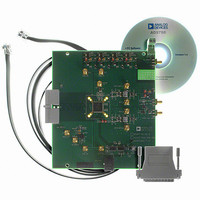AD9788-EBZ Analog Devices Inc, AD9788-EBZ Datasheet - Page 20

AD9788-EBZ
Manufacturer Part Number
AD9788-EBZ
Description
BOARD EVAL FOR AD9788
Manufacturer
Analog Devices Inc
Series
TxDAC®r
Datasheet
1.AD9785BSVZ.pdf
(64 pages)
Specifications of AD9788-EBZ
Design Resources
Powering the AD9788 Using ADP2105 for Increased Efficiency (CN0141)
Number Of Dac's
2
Number Of Bits
16
Outputs And Type
2, Differential
Sampling Rate (per Second)
800M
Data Interface
Serial
Settling Time
22ms
Dac Type
Current
Voltage Supply Source
Analog and Digital
Operating Temperature
-40°C ~ 85°C
Utilized Ic / Part
AD9788
Silicon Manufacturer
Analog Devices
Application Sub Type
DAC
Kit Application Type
Data Converter
Silicon Core Number
AD9788
Kit Contents
Board
Development Tool Type
Hardware - Eval/Demo Board
Lead Free Status / RoHS Status
Lead free / RoHS Compliant
AD9785/AD9787/AD9788
TERMINOLOGY
Integral Nonlinearity (INL)
INL is defined as the maximum deviation of the actual analog
output from the ideal output, determined by a straight line
drawn from zero scale to full scale.
Differential Nonlinearity (DNL)
DNL is the measure of the variation in analog value, normalized
to full scale, associated with a 1 LSB change in digital input code.
Monotonicity
A DAC is monotonic if the output either increases or remains
constant as the digital input increases.
Offset Error
The deviation of the output current from the ideal of zero is
called offset error. For I
inputs are all 0s. For I
inputs are set to 1.
Gain Error
The difference between the actual and ideal output span is
called gain error. The actual span is determined by the differ-
ence between the output when all inputs are set to 1 and the
output when all inputs are set to 0.
Output Compliance Range
The output compliance range is the range of allowable voltage
at the output of a current output DAC. Operation beyond the
maximum compliance limits can cause either output stage
saturation or breakdown, resulting in nonlinear performance.
Temperature Drift
Temperature drift is specified as the maximum change from the
ambient (25°C) value to the value at either T
offset and gain drift, the drift is reported in ppm of full-scale
range (FSR) per degree Celsius. For reference drift, the drift is
reported in ppm per degree Celsius.
Power Supply Rejection (PSR)
PSR is the maximum change in the full-scale output as the
supplies are varied from minimum to maximum specified
voltages.
Settling Time
Settling time is the time required for the output to reach and
remain within a specified error band around its final value,
measured from the start of the output transition.
OUTB
OUTA
, 0 mA output is expected when all
, 0 mA output is expected when the
MIN
or T
MAX
. For
Rev. A | Page 20 of 64
Spurious-Free Dynamic Range (SFDR)
Spurious-free dynamic range is the difference, in decibels,
between the peak amplitude of the output signal and the peak
amplitude of the largest spurious signal in a given frequency
band from the signal. For out-of-band SFDR, the frequency
band is 0 to one half the DAC sample rate. For in-band SFDR,
the frequency band is 0 to one half the input data rate.
Total Harmonic Distortion (THD)
THD is the ratio of the rms sum of the first six harmonic com-
ponents to the rms value of the measured fundamental. It is
expressed as a percentage or in decibels.
Noise Spectral Density (NSD)
NSD is the noise power at the analog output measured in a 1 Hz
bandwidth.
Interpolation Filter
If the digital inputs to the DAC are sampled at a multiple rate of
f
has a sharp transition band near f
appear around f
Adjacent Channel Leakage Ratio (ACLR)
ACLR is the ratio in dBc between the measured power within a
channel relative to its adjacent channel.
Complex Image Rejection
In a traditional two-part upconversion, two images are created
around the second intermediate frequency (IF). These images
have the effect of wasting transmitter power and system band-
width. By placing the real part of a second complex modulator
in series with the first complex modulator, either the upper or
lower frequency image near the second IF can be rejected.
Sinc
Sinc is shorthand for the mathematical function
This function is a useful tool for digital signal processing. The
normalized sinc function is used here and is defined as follows:
DATA
sinc(x) = sin(x)/x
sinc(x) = sin(π × x)/(π × x)
(interpolation rate), a digital filter can be constructed that
DAC
(output data rate) can be greatly suppressed.
DATA
/2. Images that typically












